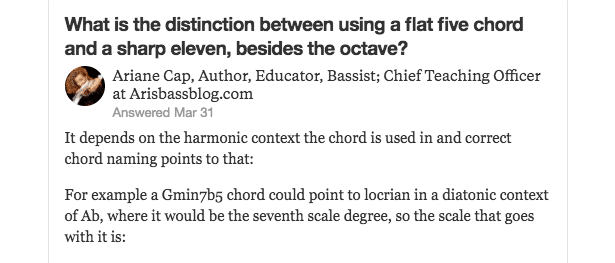Enharmonically Speaking a #11 and a b5 are the same…
What this means is that a #11 and a b5 lead you to the same note:
- The #11 from C is F#.
- The b5 from C is Gb.
Same difference, different naming. Why is it important?
Bit of an advanced theory answer below – it involves modes of melodic and harmonic minor and chord scale harmony. If this is new to you stick with the gist of this idea: that a chord can be a short cut for a scale – and that scale, then, is a possible approach for improvising. A chord symbol involving a b5 or #11 points me to different scales – because the scale with the b5 in it has that as its fifth scale degree. And the scale with the #11 in it has that as its fourth scale degree. So the scale is looking very different, as the scale with the #11 will have some sort of a 5th (augmented or perfect).
And why does it not say #4, but #11, rather? Technically you can play that 4 or 11 anywhere in the chord, but when we talk about 4 we typically mean a sus chord (substitute the 4 for the 3), and when we talk about the #11 we point to the fact that it is an extension, higher up in the chord somewhere.
Enjoy the read and let me know if you have any questions. What is cool is that harmonic minor and melodic minor also have modes and they provide beautifully colorful sounds
In my answer I address the min7b5 chord versus the min7#11 chord, which was the original question.



